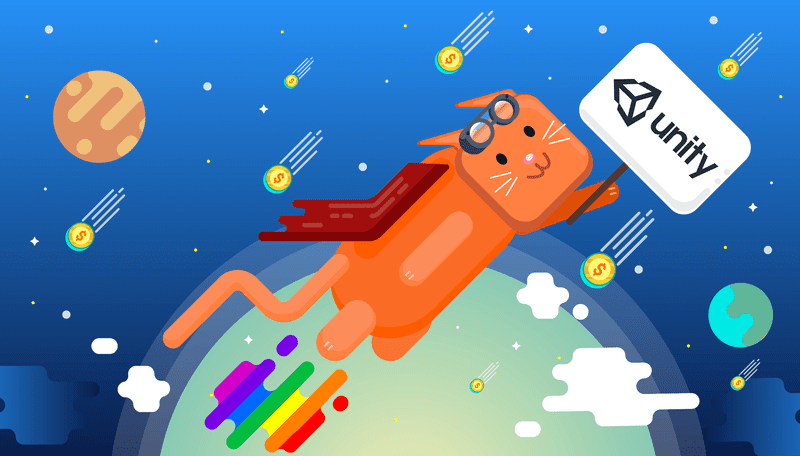How to Make Money with a Unity3D Game

The engine can be used to create games and applications for Mac, PC, iOS, and Android devices. Unity 3D is a favorite platform among indie game developers hoping to break into the industry, and is also widely used by large commercial development teams.
The Unity3D engine is flexible and easy to use, which is what makes it so attractive to indie and large-scale development companies alike. The platform also has a massive community with game developers, writers, and graphic artists who are more than willing to offer their support to newcomers. Developing a game of any size is never an easy task, but help from the Unity community and its large library of assets, tutorials, and videos makes this goal much more achievable.
After their mobile game development with Unity has progressed significantly, many game developers are ready to offer their game to the public. Whether it’s a single person handling all the work or a full dedicated team, all time and effort put into a game has value. Thus, developers naturally want to make money from their game so they can cover their expenses and turn a profit.
When it comes to making a profit, games made with Unity aren’t very different from games made with other development engines. Alternatively, with Unity cross-platform design tools, a app development company can profit from the same game on multiple platforms, significantly increasing their profit potential without adding to the workload.
There are four strategies developers can use to profit from games created with Unity3D. Be aware that most customers won’t be happy with changes after a game has launched, so plan your monetization strategy carefully prior to launching your game. To help you decide, here is an overview of each strategy’s pros and cons.
Unity Is A Cross-Platform Development Technology
1. Paid apps

|
This is the simplest and most straightforward monetization technique: after a one-time payment, players have unlimited access to the game. Paid apps have the immediate advantage of an increased perceived value. When a customer sees an app or game that costs money, they will often assume it’s of a higher quality than a free alternative. |
However, this means you will benefit more from a paid Unity3D game if you already have a dedicated fan base. If you’ve spent the last year building up buzz about your game on Facebook, marketing your website, and sharing development notes, then people will be waiting for your game launch with their wallets ready. But if nobody has ever heard of you or your game when you launch it, they’ll be far less likely to make that investment.
Another potential problem with the paid game strategy is that modern gamers are accustomed to getting games for free. Today, there are tons of free games for PC, Mac, and mobile devices. Chances are they can find a free game similar to yours, but you can counteract this setback by ensuring your game is unique and of the highest quality.
Yet another con of creating paid games is that you’ll have to constantly draw in new players or the app will stop being profitable. In most cases, developers who choose paid apps immediately begin working on their next app after launching the first. When new customers stop investing in the original app, developers can then release a second app and continue the cycle. This strategy requires a lot of work, but it has a large potential for profit if you’re willing to put in the effort.
2. Subscription model
|
This strategy is similar to the paid app method, except that payments are recurring—in most cases, monthly. This provides most of the benefits of the paid app approach but without the need to attract as many new customers, although attracting new customers on a regular basis is important no matter what monetization strategy you use. |
|
However, there are some catches to the subscription model. For example, customers expect the game to be regularly maintained and updated. They expect bugs to be addressed immediately and for developers to remain committed to the game for an extended period of time. If you’re prepared to commit to your Unity3D game, the subscription strategy may be a viable option for you.
3. In-app purchases

|
Also known as microtransactions (MTX), in-app purchases have become extremely common in the past decade. The idea is that the game itself is completely free to play, but players can spend real money on certain in-game items. MTX have the potential for massive profits, but they can also be very controversial. Even huge game development companies like EA have managed to ruin games with poorly implemented MTX. |
Many game development companies have found that cosmetic items make the least controversial in-app purchases. These can include flair, character costumes, special effects, and anything else that helps players stand out visually without giving them an in-game advantage.
At the end of the day, it’s up to you to determine acceptable microtransactions for your game. Just keep in mind that certain transactions can ruin the integrity of your game and cost you your player base.
4. Advertisements
|
The final monetization strategy is incorporating advertisements into your game. If you have any experience with online ads, you’re well familiar with how they work. Each time a person views an advertisement, you make money. And each time a person interacts with an advertisement, you make even more.
|
|
However, it is possible to have too many ads in your game. If players are being bombarded by video ads every few minutes, they will probably stop playing and leave a bad review. So keep the ads to a minimum and make sure they’re as relevant as possible.
Savvy game developers find creative ways to incorporate ads into their games, such as rewarding players with in-game content for choosing to watch an ad. This way, players can benefit from the ads too, without feeling as though they’re being forced to watch them.
As you can see, there are multiple ways to earn money from a Unity3D game. You can even combine some of these techniques to maximize your profits. For example, you can include cosmetic in-app purchases or optional rewarding ads in a paid or subscription-based game. Whether you use one or more of these techniques, it’s important to keep the user experience a priority at all times. As long as you create a great game, you should be able to make money from it!


